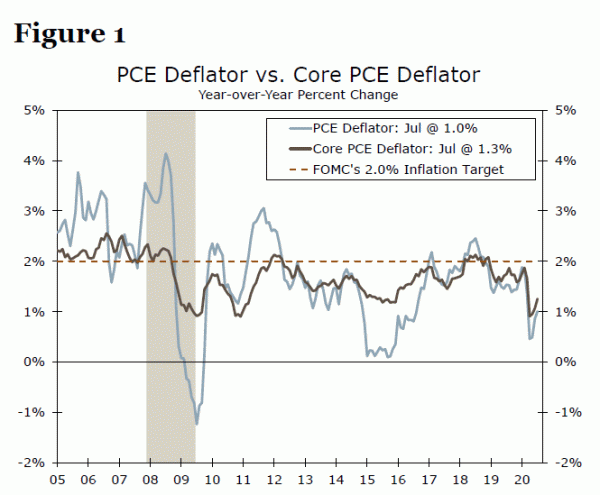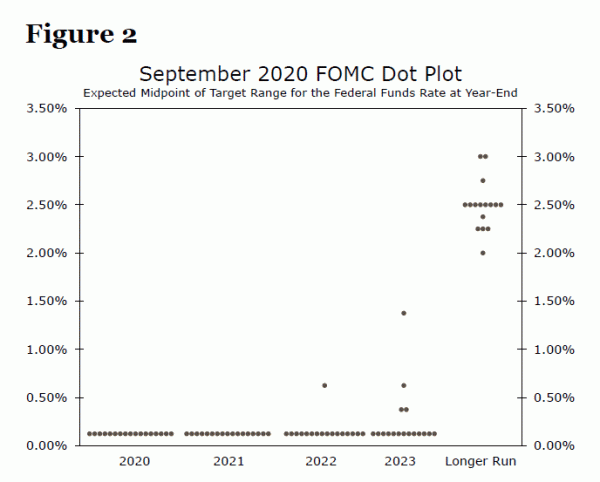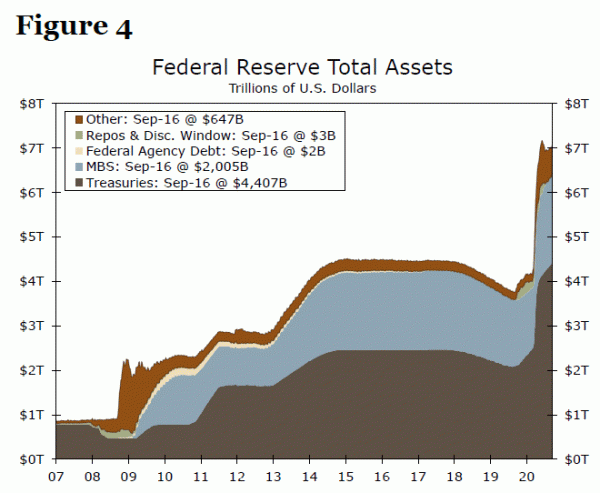Executive Summary
The change that the FOMC recently made to its policy strategy means the Committee is willing to tolerate a higher rate of inflation in the next few years. But, it may take more than simple tweaks to a policy statement to achieve this outcome. If inflation expectations do not move meaningfully higher in coming months, the FOMC may feel compelled to add more monetary accommodation. In our view, an increased pace of QE purchases of Treasury securities and MBS would be the most likely policy tool that Fed policymakers would employ, at least in the foreseeable future.
Assuming that financial market conditions do not otherwise tighten significantly in coming weeks, the FOMC could potentially sanction increased QE purchases as early as its December 15-16 meeting. In our view, yields on longer-dated Treasury securities likely would move lower, at least initially, if the Fed were to ramp up its QE purchases. However, longer-term rates, could eventually begin to drift higher if investors became convinced that the Federal Reserve would ultimately be successful in achieving a higher rate of inflation.
FOMC Indicates It Is on Hold for the Foreseeable Future
Federal Reserve Chair Jerome Powell gave a speech on August 27 for the Kansas City Fed’s Jackson Hole Symposium in which he outlined the FOMC’s new strategy. As we discussed in a previous report, the FOMC will aim to “achieve inflation that averages 2% over time.” Previously, the Committee had targeted an inflation rate of 2% without any mention of an average over time. But as Figure 1 makes clear, inflation, as measured by the year-over-year change in the personal consumption expenditures (PCE) deflator, has generally undershot 2% over the past decade. In addition, the FOMC has changed its strategy to one in which monetary policy decisions will be informed by “assessments of the shortfalls of employment from its maximum level” rather than “deviations from its maximum level.”
The practical effect of the FOMC’s change in verbiage is that it likely will remain in an accommodative policy stance for quite some time to ensure that “maximum” employment is reached and inflation trends higher. This expectation of continued monetary accommodation was corroborated by the statement that the FOMC released following its meeting on September 16. Specifically, the Committee said that it “expects it will be appropriate to maintain this target range until labor market conditions have reached levels consistent with the Committee’s assessments of maximum employment and inflation has risen to two percent and is on track to moderately exceed two percent for some time.” With the unemployment rate currently in excess of 8% and PCE inflation running well below 2% at present, the conditions that would trigger Fed tightening are nowhere close to being met. Indeed, 13 of the 17 Committee members expect the FOMC will maintain the current target range for the fed funds rate (i.e., 0.00% to 0.25%) through the end of 2023 (Figure 2).
Why Does the FOMC Want Higher Inflation?
But why does the FOMC want higher inflation? Doesn’t the Federal Reserve remember the painful experience of the 1970s and early 1980s when inflation trended higher to reach double digits? Nobody on the FOMC wants to see a return to those days. But, Fed policymakers are also aware of the experience of Japan, which has endured a mildly deflationary situation over the past two decades.1 In an environment of deflation, orthodox monetary policy becomes increasingly less effective, because central banks are not able to take real interest rates (i.e., nominal interest rates less inflation) into negative territory, which is very stimulative, if prices are falling. Indeed, the Japanese economy has been more or less moribund over the past 25 years even though the main policy rate of the Bank of Japan (BoJ) has been no higher than 0.50% over that period. The BoJ took the unorthodox step of cutting its main policy rate to -0.10% in February 2016, where it remains today, with little visible effect on the rate of economic growth and the core rate of inflation.
Although the U.S. economy is not experiencing deflation today—the year-over-year rate of core PCE inflation was 1.3% in July—it likely would not take much to approach that point. If another unforeseen shock were to send the economy tumbling back into recession, then the Federal Reserve could be staring at a potentially deflationary situation. And with the target range of the fed funds rate already at 0.00% to 0.25%, the FOMC would have little conventional “ammunition” to stimulate the economy. In short, the FOMC wants to raise inflation now so that it has farther to fall before reaching negative territory if the economy were to tumble back into recession.
Inflation expectations are a crucial determinant of the actual rate of inflation. If businesses and households expect that prices will be higher in the future, then they have an incentive to buy goods and services today at lower prices. Increased demand for goods and services pushes up their prices, everything else equal. Conversely, if individuals believe that prices will be lower in the future, then they have an incentive to postpone purchases, thereby putting downward pressure on prices of goods and services.
As shown in Figure 3, there is a fairly high degree of correlation between the year-over-year change in the core PCE deflator and the difference between the nominal yield on the 10-year Treasury security and the yield on the 10-year inflation-adjusted Treasury security. This yield spread is commonly referred to as the “breakeven inflation rate” and is a measure of the expected average rate of inflation over the next ten years. Importantly, that measure of long-run inflation expectations has been below 2% for nearly two years. Moreover, the 10-year breakeven inflation rate is actually a bit lower today than it was on August 27, the day on which Chair Powell outlined the FOMC’s new policy strategy. It will be difficult for the Fed to engineer higher inflation if it fails to raise inflation expectations.
But What if Inflation Does Not Rise Toward 2% Soon?
So if inflation expectations and/or actual inflation do not show signs of turning higher in coming months, what does the Fed do then? In our view, the FOMC will not just sit idly on its hands and hope that inflation eventually turns up. We believe that the Fed would turn even more accommodative. But how exactly?
As we noted in a previous report, we do not look for the FOMC to cut its target range for the fed funds rate into negative territory, at least not anytime soon. Numerous Fed officials, including Chair Powell, have downplayed negative rates as a policy tool, at least at this time. In addition, yield curve control, by which the Fed would purchase Treasury securities in quantities sufficient enough to keep a longer-term interest rate below some level, does not seem to be on the table at this time either.2 The minutes of the July 27 FOMC meeting show that “many participants judged that yield caps and targets were not warranted in the current environment but should remain an option that the Committee could reassess in the future if circumstances changed markedly.”
That leaves more quantitative easing (QE) as the most likely policy tool that the FOMC could employ in the near term. Between mid-March and early June the size of the Fed’s balance sheet mushroomed nearly $3 trillion (Figure 4), as the central bank significantly ramped up its purchases of Treasury securities and mortgage-backed securities (MBS), which succeeded in reducing tensions in financial markets.3 At present, the Federal Reserve is buying roughly $80 billion worth of Treasury securities and approximately $40 billion worth of MBS every month.
If the Fed were to ramp up its QE purchases, by how much would it do so? A look at the historical record may offer some clues. During its first round of QE, which spanned March 2009 through September 2009, the Federal Reserve bought about $50 billion per month of Treasury securities. The Fed then ramped up its purchases of Treasury securities to about $75 billion per month when it implemented its second QE round in November 2010.4 Using this record as a benchmark, we could see the FOMC increasing its purchase rate to $100-$120 billion per month of Treasury securities. The Committee could also sanction more monthly purchases of MBS.
What about timing? The FOMC could clearly make an announcement at any time. But, we think the Committee would want to wait until a regularly scheduled meeting to announce a policy change that is not related to an “emergency.” The next FOMC meeting is scheduled for November 4-5. In our view, Fed officials probably want to see how the recovery is progressing and how inflation is faring before ramping up QE purchases even further. So the November meeting, which is only six weeks away, seems to be a bit premature.
But by the December meeting (December 15-16), the Fed officials will have two-to-three more months of data to digest. If it appears that the economy is in danger of stalling, inflation still appears to be running less than 2% or measures of inflation expectations are not trending higher, we could see the FOMC ramping up the Fed’s pace of QE purchases as early as the December meeting. We are not suggesting that the Committee will necessarily announce an increase in QE purchases at the December FOMC meeting. Fed policymakers could very well want to see even more data before implementing further monetary accommodation. But the FOMC moved rapidly and with force in March to address the dislocations that were occurring in the economy at that time, so we would not be shocked if the Committee announced an increase in QE purchases as early as the December meeting. Of course, the Federal Reserve could ramp up its pace of QE purchases much sooner than December if financial markets encounter another period of heightened volatility as they did earlier this year.
What potential effects would an increase in QE purchases have? Figure 3 shows that the 10-year breakeven inflation rate rose by about one percentage point during the Fed’s second round of QE in late 2010/early 2011. So an increase in the Fed’s pace of QE purchases could potentially have the desired effect of raising inflation expectations.
There is also the effect on market-determined interest rates to consider. In our view, an increase in QE purchases likely would have little effect on the front end of the yield curve, because short-term rates are largely determined by expectations of the fed funds rate over the next few years. A change in QE purchases, in the absence of other policy changes, likely would not lead to a meaningful reassessment of expectations of the future path of the fed funds rate among market participants. But longer terms rates likely would decline, at least initially, if the Federal Reserve were to increase its purchases of long-dated Treasury securities. However, longer-term rates, which are influenced by inflation expectations, could eventually begin to drift higher if investors became convinced that the Federal Reserve would ultimately be successful in achieving a higher rate of inflation.
1 The deflator on household consumption expenditures in Japan fell 8% between 1998 and 2019, which represents an average rate of deflation of roughly 0.37% per annum over that period.
2 See “July Flashlight for the FOMC Blackout Period” (July 20, 2020) for a discussion of how yield curve control has been implemented in some economies.
3 The Federal Reserve also provided more than $400 billion of swap lines to foreign central banks to ease tensions in dollar funding markets.
4 The Fed then moved to an open-ended commitment of $45 billion per month starting in January 2013. The Federal Reserve also bought roughly $1.75 trillion worth of MBS between 2008 and 2014.
















